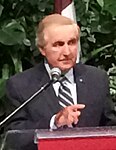| |||||||||||||||||||||||||||||||||||||||||||||||||||||
58 seats in the Legislative Assembly of Saskatchewan 30 seats needed for a majority | |||||||||||||||||||||||||||||||||||||||||||||||||||||
|---|---|---|---|---|---|---|---|---|---|---|---|---|---|---|---|---|---|---|---|---|---|---|---|---|---|---|---|---|---|---|---|---|---|---|---|---|---|---|---|---|---|---|---|---|---|---|---|---|---|---|---|---|---|
| Turnout | 64.6% [1] ( | ||||||||||||||||||||||||||||||||||||||||||||||||||||
| |||||||||||||||||||||||||||||||||||||||||||||||||||||
 | |||||||||||||||||||||||||||||||||||||||||||||||||||||
| |||||||||||||||||||||||||||||||||||||||||||||||||||||
The 1995 Saskatchewan general election was held on June 21, 1995 to elect members of the Legislative Assembly of Saskatchewan.
The New Democratic Party government of Premier Roy Romanow was re-elected for a second term, although with a reduced majority.
The Liberal Party – led by Lynda Haverstock – increased its share of the popular vote; adding 9 seats in the legislature to the two seats it held previously, and became the official opposition.
Saskatchewan voters continued to punish the Progressive Conservative Party in the wake of prosecutions of former Progressive Conservative politicians for expense account fraud. Under the leadership of Bill Boyd the party continued to lose votes, and its caucus was reduced from 10 members to 5.

